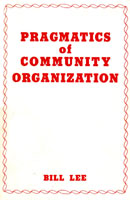
Pragmatics of Community Organization
First Edition
Lee, Bill
Publisher: Common Act Press, Canada
Year Published: 1986
Pages: 172pp ISBN: 0-921159-00-5
Library of Congress Number: HV41.L43 1986 Dewey: 361.8
Resource Type: Book
Cx Number: CX3254
Information on how to plan action, how to organize meetings, how to train participants for action, how to negotiate, and how to end a particular exercise in community organization.
Abstract:
This abstract is for the first edition, published 1986. For information about the 4th edition, see CX3254B.
PRAGMATICS OF COMMUNITY ORGANIZATION defines community organization as "intervention which through the facilitation of collective action on the part of its clientele, seeks to maximize the ability of disadvantaged people to effect (sic) their environment so that they are able to meet their psychological, social, and material needs. This intervention involves the creatiion of representative organizations which can develop the power and resources to change inadequate institutions and laws or build new ones that will be more responsive to their needs and those of all human beings."
Community organizing is seen as involving three major themes:
1. Its purpose is to change power relationships.
2. The changes being sought are not detrimental to the legitimate human needs of any other group.
3. It involves collective participation in decision-making.
The model used in PRAGMATICS OF COMMUNITY ORGANIZAITON is an academic one, occasionally relying heavily on socialogical jargon. At the same time, the book contains useful practical information on how to plan action, how to organize meetings, how to train participants for action, how to negotiate, and how to end a particular exercise in community organization. It stresses the importance of addressing the issue of power in community organizing, but in fact fails to actually do so itself, lending the book a vague and incomplete air.
Table of Contents
Acknowledgements
A Note on the Use of this Book
Notes on Use and Pronouns
Introduction
History
A Framework
Three Themes
Chapter I Social Structure, Class and Equity
Power Based Theory of Dysfunction
Some Important Concepts
Power
Organization Structure
Theory of Practice
Chapter II Pre Entry
Internal Political Situation
External Political Situation
Sponsor's Ultimate Interests
Sponsor's Objective
Taboo Issues?
Taboo People or Institutions
Time Frame
Accountability
Evaluations
Conclusion
Chapter III Contact and Entry
Establishing Contact
Image of Funding Body
Image of Organizers
Beginning Where the People Are
Broad Contact
Credible Contacts
Chapter IV Community Analysis
Teacher Facilitator Role
Assumptions
Pitfalls of Immediate Action
Objectives
Action Reasearch Steps - I Brainstorm Meeting
Step II Survey Instrument and Report
Step III Second Round of Questioning
Format for Second Round
Chapter V Implementation
Meetings
Organizing Priorities
Analyzing Objectives
Maintaining the Group or Organization
Planning
Training
Internal Opposition
Chapter VI Action
Funding
Demonstrations
Negotiation
Civil Disobedience
Chapter VII Evaluation
Importance
Principles
Content Areas
Chapter VIII The End
Reasons for Leaving
Leave Taking
Negative Possibilities
Positive Possibilities
Priciples
Conclusion
Glossary of Terms
Bibliography
Subject Headings


